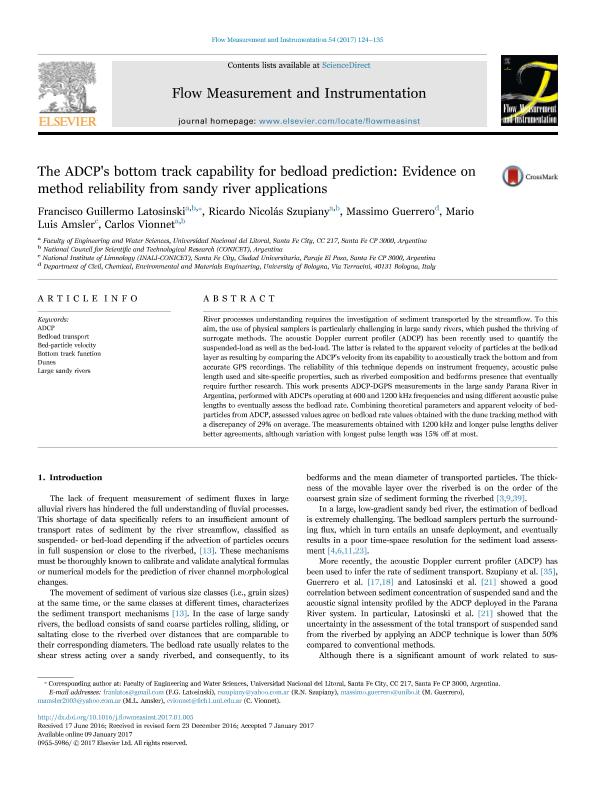Mostrar el registro sencillo del ítem
dc.contributor.author
Latosinski, Francisco Guillermo

dc.contributor.author
Szupiany, Ricardo Nicolas

dc.contributor.author
Guerrero, Massimo
dc.contributor.author
Amsler, Mario Luis

dc.contributor.author
Vionnet, Carlos Alberto

dc.date.available
2018-11-09T21:44:23Z
dc.date.issued
2017-04
dc.identifier.citation
Latosinski, Francisco Guillermo; Szupiany, Ricardo Nicolas; Guerrero, Massimo; Amsler, Mario Luis; Vionnet, Carlos Alberto; The ADCP's bottom track capability for bedload prediction: Evidence on method reliability from sandy river applications; Elsevier; Flow Measurement And Instrumentation; 54; 4-2017; 124-135
dc.identifier.issn
0955-5986
dc.identifier.uri
http://hdl.handle.net/11336/64170
dc.description.abstract
River processes understanding requires the investigation of sediment transported by the streamflow. To this aim, the use of physical samplers is particularly challenging in large sandy rivers, which pushed the thriving of surrogate methods. The acoustic Doppler current profiler (ADCP) has been recently used to quantify the suspended-load as well as the bed-load. The latter is related to the apparent velocity of particles at the bedload layer as resulting by comparing the ADCP's velocity from its capability to acoustically track the bottom and from accurate GPS recordings. The reliability of this technique depends on instrument frequency, acoustic pulse length used and site-specific properties, such as riverbed composition and bedforms presence that eventually require further research. This work presents ADCP-DGPS measurements in the large sandy Parana River in Argentina, performed with ADCPs operating at 600 and 1200 kHz frequencies and using different acoustic pulse lengths to eventually assess the bedload rate. Combining theoretical parameters and apparent velocity of bed-particles from ADCP, assessed values agree on bedload rate values obtained with the dune tracking method with a discrepancy of 29% on average. The measurements obtained with 1200 kHz and longer pulse lengths deliver better agreements, although variation with longest pulse length was 15% off at most.
dc.format
application/pdf
dc.language.iso
eng
dc.publisher
Elsevier

dc.rights
info:eu-repo/semantics/openAccess
dc.rights.uri
https://creativecommons.org/licenses/by-nc-sa/2.5/ar/
dc.subject
Adcp
dc.subject
Bed-Particle Velocity
dc.subject
Bedload Transport
dc.subject
Bottom Track Function
dc.subject
Dunes
dc.subject
Large Sandy Rivers
dc.subject.classification
Meteorología y Ciencias Atmosféricas

dc.subject.classification
Ciencias de la Tierra y relacionadas con el Medio Ambiente

dc.subject.classification
CIENCIAS NATURALES Y EXACTAS

dc.title
The ADCP's bottom track capability for bedload prediction: Evidence on method reliability from sandy river applications
dc.type
info:eu-repo/semantics/article
dc.type
info:ar-repo/semantics/artículo
dc.type
info:eu-repo/semantics/publishedVersion
dc.date.updated
2018-10-23T20:40:40Z
dc.journal.volume
54
dc.journal.pagination
124-135
dc.journal.pais
Países Bajos

dc.journal.ciudad
Amsterdam
dc.description.fil
Fil: Latosinski, Francisco Guillermo. Consejo Nacional de Investigaciones Científicas y Técnicas. Centro Científico Tecnológico Conicet - Santa Fe; Argentina. Universidad Nacional del Litoral. Facultad de Ingeniería y Ciencias Hídricas; Argentina
dc.description.fil
Fil: Szupiany, Ricardo Nicolas. Universidad Nacional del Litoral. Facultad de Ingeniería y Ciencias Hídricas; Argentina. Consejo Nacional de Investigaciones Científicas y Técnicas. Centro Científico Tecnológico Conicet - Santa Fe; Argentina
dc.description.fil
Fil: Guerrero, Massimo. Universidad de Bologna; Italia
dc.description.fil
Fil: Amsler, Mario Luis. Consejo Nacional de Investigaciones Científicas y Técnicas. Centro Científico Tecnológico Conicet - Santa Fe. Instituto Nacional de Limnología. Universidad Nacional del Litoral. Instituto Nacional de Limnología; Argentina
dc.description.fil
Fil: Vionnet, Carlos Alberto. Consejo Nacional de Investigaciones Científicas y Técnicas. Centro Científico Tecnológico Conicet - Santa Fe; Argentina. Universidad Nacional del Litoral. Facultad de Ingeniería y Ciencias Hídricas; Argentina
dc.journal.title
Flow Measurement And Instrumentation

dc.relation.alternativeid
info:eu-repo/semantics/altIdentifier/doi/https://doi.org/10.1016/j.flowmeasinst.2017.01.005
dc.relation.alternativeid
info:eu-repo/semantics/altIdentifier/url/https://www.sciencedirect.com/science/article/pii/S0955598617300079
Archivos asociados
